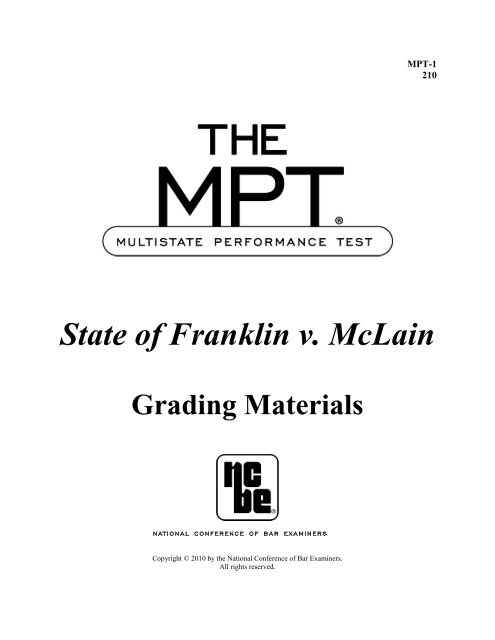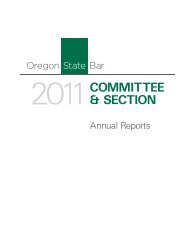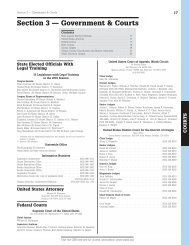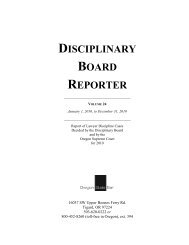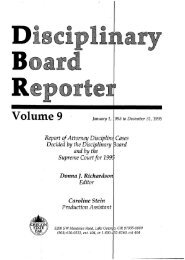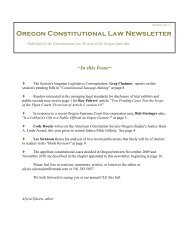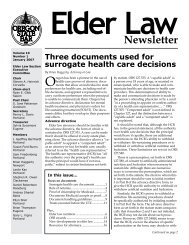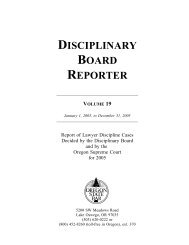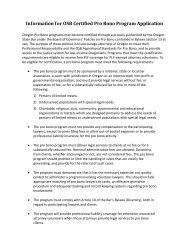State of Franklin v. McLain - Oregon State Bar
State of Franklin v. McLain - Oregon State Bar
State of Franklin v. McLain - Oregon State Bar
Create successful ePaper yourself
Turn your PDF publications into a flip-book with our unique Google optimized e-Paper software.
MPT-1<br />
210<br />
<strong>State</strong> <strong>of</strong> <strong>Franklin</strong> v. <strong>McLain</strong><br />
Grading Materials<br />
Copyright © 2010 by the National Conference <strong>of</strong> <strong>Bar</strong> Examiners.<br />
All rights reserved.
The MPT point sheet, grading summary, and grading guidelines describe the factual and legal points<br />
encompassed within the lawyering task to be completed. They outline all the possible issues and points<br />
that might be addressed by an applicant. They are provided to the user jurisdictions for the sole purpose <strong>of</strong><br />
assisting graders in grading the examination by identifying the issues and suggesting the resolution <strong>of</strong> the<br />
problem contemplated by the drafters. These are not <strong>of</strong>ficial grading guides. Applicants can receive a<br />
range <strong>of</strong> passing grades, including excellent grades, without covering all the points discussed in these<br />
guides. The model answer is included as an illustration <strong>of</strong> a thorough and detailed response to the task,<br />
one that addresses all the legal and factual issues the drafters intended to raise in the problem. It is<br />
intended to serve only as an example. Applicants need not present their responses in the same way to<br />
receive good grades. User jurisdictions are free to modify these grading materials, including the suggested<br />
weights assigned to particular points. Grading the MPT is the exclusive responsibility <strong>of</strong> the jurisdiction<br />
using the MPT as part <strong>of</strong> its admissions process.
Point Sheet
<strong>State</strong> <strong>of</strong> <strong>Franklin</strong> v. <strong>McLain</strong><br />
DRAFTERS’ POINT SHEET<br />
In this performance item, applicants’ firm represents Brian <strong>McLain</strong>, who has been<br />
charged with violating various sections <strong>of</strong> the <strong>Franklin</strong> Criminal Code dealing with<br />
methamphetamine, a controlled substance. The charges are based on evidence seized from<br />
<strong>McLain</strong> after police, acting on an anonymous tip, stopped him for investigatory purposes. The tip<br />
was called in to the <strong>Franklin</strong> “CrimeStoppers Hotline” stating that a man had been seen at a<br />
convenience store purchasing items which, although innocent in themselves, are known<br />
ingredients <strong>of</strong> methamphetamine production, and leaving the scene in a red Jeep Cherokee. A<br />
<strong>Franklin</strong> police <strong>of</strong>ficer, responding to the tip, spotted <strong>McLain</strong>, who generally matched the<br />
personal description given by the tipster, and who was driving a red Jeep Cherokee in a relatively<br />
high-crime area. After brief questioning, <strong>McLain</strong> gave consent for the <strong>of</strong>ficer to search his car.<br />
The <strong>of</strong>ficer found the goods described in the tip, together with a small plastic bag containing<br />
what appeared to be a marijuana cigarette. <strong>McLain</strong> was arrested and booked, at which time<br />
police discovered $320 in cash in <strong>McLain</strong>’s wallet. <strong>McLain</strong> then directed the police to a “meth<br />
lab” where they found chemicals and equipment that had been used to manufacture<br />
methamphetamine as well as 18 grams <strong>of</strong> the drug.<br />
<strong>McLain</strong> was charged with three felony counts: possession <strong>of</strong> methamphetamine with<br />
intent to distribute, possession <strong>of</strong> equipment with intent to manufacture methamphetamine, and<br />
manufacture <strong>of</strong> methamphetamine—all in violation <strong>of</strong> the <strong>Franklin</strong> Criminal Code. He has<br />
moved to suppress all evidence seized by police on the ground that the <strong>of</strong>ficer lacked reasonable<br />
suspicion to stop him on the evening in question. He has also moved to dismiss the charge <strong>of</strong><br />
possession <strong>of</strong> equipment with intent to manufacture methamphetamine on the ground that it is a<br />
lesser-included <strong>of</strong>fense <strong>of</strong> manufacture <strong>of</strong> methamphetamine. Applicants’ task is to draft the<br />
arguments in support <strong>of</strong> both motions.<br />
The File consists <strong>of</strong> a memorandum from the supervising attorney describing the<br />
assignment (the task memo), the criminal complaint, the motion to suppress evidence and to<br />
dismiss Count Two, the transcript <strong>of</strong> the call to the <strong>Franklin</strong> CrimeStoppers Hotline, and portions<br />
<strong>of</strong> the transcript <strong>of</strong> the evidentiary hearing. The Library contains the relevant <strong>Franklin</strong> statutes<br />
and three cases—two relating to anonymous tips and investigatory stops, and one dealing with<br />
lesser-included <strong>of</strong>fenses.<br />
1
The following discussion covers all the points the drafters intended to raise in the<br />
problem. Applicants need not cover them all to receive passing or even excellent grades. Grading<br />
is left entirely to the discretion <strong>of</strong> the user jurisdictions.<br />
I. Format and Overview<br />
The task memo directs applicants not to prepare a separate statement <strong>of</strong> facts; however,<br />
applicants are expected to draft a detailed analysis in which they incorporate the relevant facts<br />
and address the applicable legal authorities. Applicants’ work product should be written in<br />
persuasive “argument” form, pointing out (a) the legal standards governing the issues and (b)<br />
why, based on the relevant facts <strong>of</strong> record, those standards are or are not met in this case.<br />
As stated in the task memo, applicants have two motions to discuss: a motion to suppress<br />
evidence on the ground that there was not reasonable suspicion for the <strong>of</strong>ficer to stop <strong>McLain</strong><br />
and a motion to dismiss one <strong>of</strong> the three counts on multiplicity grounds.<br />
II.<br />
Discussion<br />
A. The Motion to Suppress<br />
Applicants are asked to draft the argument portion <strong>of</strong> the brief in support <strong>of</strong> <strong>McLain</strong>’s<br />
motion to suppress all evidence resulting from the “stop.” The legal standards applicable to<br />
investigatory stops by police (<strong>of</strong>ten called “Terry stops” after the leading case, Terry v. Ohio,<br />
392 U.S. 1 (1968)) are described in <strong>State</strong> v. Montel (<strong>Franklin</strong> Ct. App. 2003). The Fourth<br />
Amendment protects individuals from unreasonable searches, but, under Terry, police <strong>of</strong>ficers<br />
have the right to stop and interrogate persons “reasonably suspected <strong>of</strong> criminal conduct”; the<br />
basic test is whether the <strong>of</strong>ficers have “a reasonable suspicion, grounded in specific and<br />
articulable facts, that the person [is] involved in criminal activity” at the time. To make that<br />
determination, courts will consider the totality <strong>of</strong> the circumstances <strong>of</strong> each case.<br />
• Similar to the facts in Montel, the <strong>of</strong>ficer stopped <strong>McLain</strong> after an anonymous tip<br />
was called in to the <strong>Franklin</strong> CrimeStoppers Hotline. While a tip from a recognized<br />
(and familiar) police informant may be sufficient, in and <strong>of</strong> itself, to justify a Terry<br />
stop, where the tipster is anonymous, or unknown to the <strong>of</strong>ficers, there must be<br />
corroboration—usually by investigation or independent police observation <strong>of</strong><br />
unusually suspicious conduct.<br />
2
• Other important considerations in evaluating an anonymous tip are (a) whether the<br />
tipster’s information is based on his or her personal observation or “firsthand<br />
account” <strong>of</strong> a crime (or, for example, whether it is hearsay); (b) the strength and<br />
reliability <strong>of</strong> the tip with respect to its assertion <strong>of</strong> illegal activity, not just its<br />
tendency to identify a determinate person; and (c) the time that has elapsed between<br />
the reported crime and the stop.<br />
• Here, the relevant facts are as follows:<br />
• The <strong>of</strong>ficer had information that an anonymous person had telephoned a<br />
report that a “scuzzy looking” white male, “maybe mid-20s,” with dark hair<br />
and a goatee, wearing jeans and a dark hooded sweatshirt, was seen<br />
purchasing two packages <strong>of</strong> Sudafed cold medicine and some c<strong>of</strong>fee filters at<br />
Shop-Mart, a convenience store, and asking the cashier whether the store had<br />
stopped selling automobile engine-starter fluid.<br />
• The tipster asserted that the man was “clearly up to something,” and he told<br />
the hotline that the man was leaving the store and heading toward a red Jeep<br />
Cherokee in the parking lot.<br />
• Officer Simon, who took the report from the dispatcher, was aware, as a<br />
trained and experienced police <strong>of</strong>ficer, that cold medicine such as Sudafed<br />
can be processed to produce a key element <strong>of</strong> methamphetamine, and that<br />
c<strong>of</strong>fee filters and engine-starter fluid are also used in the process.<br />
• Simon responded promptly to Shop-Mart and saw a man (<strong>McLain</strong>) matching<br />
the tipster’s description come out <strong>of</strong> a grocery store across the street from the<br />
convenience store carrying a small paper bag.<br />
• <strong>McLain</strong> got into a red Jeep Cherokee parked in front <strong>of</strong> the store and drove<br />
<strong>of</strong>f, with Simon following in his squad car. Simon saw <strong>McLain</strong> stop in front<br />
<strong>of</strong> an apartment building, talk briefly with a man there, and pull the Jeep into<br />
an adjoining alley, where Simon initiated the Terry stop.<br />
After recognizing the general principles applicable to investigatory (Terry) stops, the<br />
argument should make the following points:<br />
• There was no reason—other than the brief anonymous telephone call to the<br />
hotline—to suspect <strong>McLain</strong> <strong>of</strong> any criminal activity whatsoever.<br />
• While information provided to police from known informants may be considered<br />
sufficiently reliable to justify a Terry stop, an anonymous tip must be corroborated<br />
3
y independent observation or investigation before police may reasonably execute<br />
an investigatory stop.<br />
• Here, neither Simon nor any other <strong>of</strong>ficer undertook any independent investigation.<br />
Simon made no independent observations, other than to note, while following<br />
<strong>McLain</strong>’s car, that (a) he matched the tipster’s description, (b) he was driving in an<br />
area Simon knew had been the subject <strong>of</strong> some unknown number <strong>of</strong> criminal<br />
activity reports in the past year (Simon himself had made a marijuana arrest there),<br />
and (c) <strong>McLain</strong> had had a brief conversation with a man in front <strong>of</strong> a building.<br />
These facts do not constitute sufficient corroboration.<br />
• In support <strong>of</strong> their arguments, applicants should cite <strong>State</strong> v. Washington<br />
(quoted in <strong>State</strong> v. Montel), which held that even where the <strong>of</strong>ficers knew that<br />
the neighborhood in which they encountered the defendant was a high-crime<br />
area known for drug activity, that fact alone did not provide police with<br />
reasonable suspicion to make an investigatory stop.<br />
• Indeed, here, while there had been reports <strong>of</strong> criminal activity in the area,<br />
none <strong>of</strong> them related to large-scale drug operations.<br />
• And the only other “evidence” Simon had was the anonymous report that<br />
<strong>McLain</strong> had, perfectly legally, purchased two packages <strong>of</strong> cold medicine<br />
and some c<strong>of</strong>fee filters, and had asked the store clerk about engine-starter<br />
fluid.<br />
Further, applicants should recognize that an anonymous tip must be “reliable in its<br />
assertion <strong>of</strong> illegality, not just in its tendency to identify a determinate person.” Florida v. J.L.<br />
(cited in <strong>State</strong> v. Montel).<br />
• The argument can be made that identifying <strong>McLain</strong> is really all the tip did in this<br />
case, because the only other information was that he had made a few purchases <strong>of</strong><br />
concededly legal items at Shop-Mart.<br />
• Other applicants may emphasize that the tip here was <strong>of</strong> such a “low degree <strong>of</strong><br />
reliability” that “more information was necessary to establish the requisite<br />
quantum <strong>of</strong> suspicion” and that there is no such evidence or information in the<br />
record. See Montel.<br />
• Applicants might note that in contrast to the defendant in Montel, whom<br />
the arresting <strong>of</strong>ficer knew to be a gang member charged with a weapons<br />
<strong>of</strong>fense, <strong>McLain</strong> was unknown to Officer Simon, who had no reason to<br />
4
suspect that he was involved in dealing methamphetamine or any other<br />
illegal activity.<br />
• However, astute applicants should anticipate that the prosecution will likely argue<br />
that Officer Simon’s training and experience may well constitute the type <strong>of</strong><br />
“independent observation” that can provide the corroboration necessary to<br />
legitimize the stop. Applicants should argue that the cases make no mention <strong>of</strong><br />
training and experience as a substitute for actual, situation-specific independent<br />
investigation and observation.<br />
• In addition, it can be argued that there is scant evidence that the 8th Street area,<br />
where <strong>McLain</strong> was stopped, has a reputation for drug activity. In <strong>State</strong> v. Sneed<br />
(cited in Montel) the court, in granting the motion to suppress, emphasized that a<br />
tip about drug activity at a particular house in a particular neighborhood did not<br />
provide reasonable suspicion where there was no evidence at the hearing that the<br />
area “was known for drug trafficking.” Again, applicants should point out that all<br />
the <strong>of</strong>ficer in this case knew was that there had been several reports <strong>of</strong> criminal<br />
activity in the area—one involving cultivation <strong>of</strong> marijuana—but nothing to<br />
indicate the production <strong>of</strong> methamphetamine as suggested by the tip in this case.<br />
• Further, Officer Simon testified that the only arrests made at the Shop-Mart have<br />
been for vandalism and shoplifting. There is no evidence <strong>of</strong> suspicious methrelated<br />
activity or purchases.<br />
• Applicants are instructed to anticipate the <strong>State</strong>’s principal arguments and briefly<br />
challenge them. In particular, they should anticipate the <strong>State</strong>’s likely reliance on the<br />
per curiam opinion in <strong>State</strong> v. Grayson (<strong>Franklin</strong> Ct. App. 2007). In Grayson, the<br />
court held that the tip was adequately corroborated by “independent police work”<br />
where the <strong>of</strong>ficers observed a man meeting the tipster’s description driving a car that<br />
met the tipster’s description to a destination predicted in the tip. This ties in with a<br />
likely argument by the <strong>State</strong> that the tip’s accuracy is enhanced because it was the<br />
result <strong>of</strong> the tipster’s “personal observation”—which the Montel court recognizes as<br />
sometimes being a significant factor in determining the reliability <strong>of</strong> an anonymous<br />
tip.<br />
• There is, however, a difference in the nature <strong>of</strong> the tips in Grayson and in the<br />
instant case. In Grayson, the tipster alleged knowledge <strong>of</strong> actual criminal<br />
activity—that the defendant was in possession <strong>of</strong> an illegal drug, which he was<br />
5
transporting to a specific address; and the police <strong>of</strong>ficers’ observations<br />
corroborated most aspects <strong>of</strong> the tip. Here, the tip alleged only conduct that was<br />
perfectly legal—buying medicine, c<strong>of</strong>fee filters, etc.—and better applicants<br />
should at least attempt to distinguish Grayson on that basis.<br />
B. The Motion to Dismiss Count Two <strong>of</strong> the Complaint<br />
The charges in counts one, two, and three <strong>of</strong> the complaint arise from the chemicals,<br />
drug-manufacturing apparatus, and 18 grams <strong>of</strong> methamphetamine found in <strong>McLain</strong>’s “meth<br />
lab” after his arrest. The task memo instructs applicants to draft the argument in support <strong>of</strong><br />
defendant’s motion to dismiss the “manufacturing equipment” count (Count Two) on the ground<br />
that it is a lesser-included <strong>of</strong>fense <strong>of</strong> manufacture <strong>of</strong> methamphetamine (Count<br />
Three), and that therefore the complaint contains multiplicitous counts. A multiplicitous<br />
complaint raises double jeopardy concerns due to the possibility that the defendant will receive<br />
more than one sentence for a single <strong>of</strong>fense.<br />
• <strong>State</strong> v. Decker (<strong>Franklin</strong> Sup. Ct. 2005) provides the legal framework for analyzing<br />
whether one charge is a lesser-included <strong>of</strong>fense <strong>of</strong> another. Decker follows the<br />
“strict elements” test established by the leading case, Blockburger v. United <strong>State</strong>s,<br />
284 U.S. 299 (1932). Under the strict elements test, where two or more <strong>of</strong>fenses<br />
arise from the same act or transaction and the elements <strong>of</strong> the “greater” crime<br />
necessarily include the elements <strong>of</strong> the “lesser” crime, the latter <strong>of</strong>fense is a lesserincluded<br />
<strong>of</strong>fense. Under Blockburger, which is codified in Fr. Crim. Code § 5(2),<br />
the court compares the elements <strong>of</strong> both <strong>of</strong>fenses. If the comparison establishes that<br />
the elements <strong>of</strong> one <strong>of</strong>fense are subsumed within those <strong>of</strong> the other, the former is a<br />
lesser-included <strong>of</strong>fense, and a prosecution for both <strong>of</strong>fenses places the defendant in<br />
double jeopardy. As an introductory matter, applicants should argue that both<br />
counts arise from the same course <strong>of</strong> conduct: <strong>McLain</strong>’s alleged operation <strong>of</strong> a meth<br />
lab. Following the court’s approach in Decker, applicants should examine the<br />
criminal complaint against <strong>McLain</strong> and the relevant sections <strong>of</strong> the <strong>Franklin</strong><br />
Criminal Code and then identify the distinct elements <strong>of</strong> each charged <strong>of</strong>fense.<br />
6
• Count Two charges <strong>McLain</strong> with possession <strong>of</strong> equipment with the intent to<br />
manufacture methamphetamine, a violation <strong>of</strong> Fr. Crim. Code § 43. The elements <strong>of</strong><br />
that <strong>of</strong>fense are that the defendant<br />
(a) knowingly<br />
(b) possessed equipment or chemicals, or both,<br />
(c) for the purpose <strong>of</strong> manufacturing a controlled substance, to wit,<br />
methamphetamine.<br />
• Count Three charges a violation <strong>of</strong> § 51, manufacture <strong>of</strong> methamphetamine. The<br />
elements <strong>of</strong> that <strong>of</strong>fense are that the defendant<br />
(a) knowingly<br />
(b) engaged in the manufacture <strong>of</strong> methamphetamine.<br />
• The intent element is identical for both <strong>of</strong>fenses. A textual comparison <strong>of</strong> the<br />
elements demonstrates that the lesser <strong>of</strong>fense contains the same intent element as<br />
the greater <strong>of</strong>fense. Both <strong>of</strong>fenses require that the person who commits either crime<br />
do so “knowingly.”<br />
• Astute applicants will recognize that the elements <strong>of</strong> possession <strong>of</strong> equipment do<br />
not fall as neatly into the elements <strong>of</strong> the greater <strong>of</strong>fense, manufacture <strong>of</strong><br />
methamphetamine, as do the elements <strong>of</strong> the burglary and assault charges at issue in<br />
Decker.<br />
• At first glance, it is the lesser <strong>of</strong>fense, possession <strong>of</strong> equipment with the intent to<br />
manufacture methamphetamine, which requires an element not present in the<br />
greater <strong>of</strong>fense—the possession <strong>of</strong> equipment and supplies; section 51 provides<br />
simply that “[i]t is unlawful for any person to knowingly manufacture<br />
methamphetamine.”<br />
• The question then becomes whether, under the statutes, a person is able to<br />
manufacture methamphetamine without possessing the laboratory equipment and<br />
supplies used to make it, and the answer is “no.” Or, as stated in Decker, “it is<br />
impossible to commit the greater <strong>of</strong>fense without first having committed the lesser<br />
<strong>of</strong>fense.”<br />
• Applicants should take care to distinguish <strong>State</strong> v. Jackson (Fr. Ct. App. 1992),<br />
cited in Decker. In Jackson, the defendant was charged with possessing cocaine in<br />
the form <strong>of</strong> residue found inside a crack cocaine pipe. He appealed the trial court’s<br />
denial <strong>of</strong> his motion for a jury instruction on the <strong>of</strong>fense <strong>of</strong> possession <strong>of</strong> drug<br />
paraphernalia, arguing that it was a lesser-included <strong>of</strong>fense <strong>of</strong> cocaine possession.<br />
7
In rejecting this argument, the court <strong>of</strong> appeal explained, “One may be in possession<br />
<strong>of</strong> drugs, but not paraphernalia. One may possess paraphernalia without possessing<br />
drugs.” In short, one <strong>of</strong>fense could be committed without also committing the other<br />
<strong>of</strong>fense.<br />
• By contrast, in <strong>McLain</strong>’s case, the lesser <strong>of</strong>fense is composed <strong>of</strong> some, but not all,<br />
<strong>of</strong> the elements <strong>of</strong> the greater <strong>of</strong>fense, so that it is impossible to commit the greater<br />
<strong>of</strong>fense, the manufacture <strong>of</strong> methamphetamine, without also first committing the<br />
lesser, possession <strong>of</strong> equipment and supplies with the intent to manufacture<br />
methamphetamine.<br />
Accordingly, there is a reasonable argument to be made that under the Blockburger test,<br />
the court should dismiss Count Two as multiplicitous.<br />
8
Grading Summary<br />
and<br />
Grading Guidelines
Multistate Performance Test<br />
9<br />
<strong>State</strong> <strong>of</strong> <strong>Franklin</strong> v. <strong>McLain</strong><br />
GRADING SUMMARY<br />
The client, Brian <strong>McLain</strong>, is charged with three methamphetamine <strong>of</strong>fenses, including the manufacture<br />
<strong>of</strong> the drug. Police stopped <strong>McLain</strong> on an anonymous tip that he was seen buying items used to make<br />
meth. Applicants must draft arguments in support <strong>of</strong> suppressing evidence seized, arguing that there was<br />
no reasonable suspicion for the stop, and dismissing Count Two (possession <strong>of</strong> equipment with intent to<br />
manufacture) as a lesser-included <strong>of</strong>fense <strong>of</strong> Count Three (manufacture <strong>of</strong> meth).<br />
I. Because the stop was based on an uncorroborated anonymous tip, the resulting evidence<br />
should be suppressed.<br />
(65% total weight)<br />
• Police need reasonable suspicion that criminal activity is afoot to make an investigatory stop. Terry.<br />
• To rise to reasonable suspicion, an anonymous tip must be corroborated. Sneed.<br />
• Here, the anonymous tip was not corroborated by investigation or police observation. (35%)<br />
• The extent <strong>of</strong> Simon’s independent investigation was observing that (1) <strong>McLain</strong> matched the<br />
tip’s description, (2) he drove to an area that had had some drug activity, and (3) he briefly spoke<br />
to a man in front <strong>of</strong> a building.<br />
• The <strong>State</strong> may argue that Simon’s training/experience is an “independent observation.”<br />
• But his observation <strong>of</strong> <strong>McLain</strong> is not tied to his experience re: meth dealers.<br />
• Simon concedes that 2 boxes <strong>of</strong> Sudafed could not make an appreciable amount <strong>of</strong> meth.<br />
• By contrast, in Grayson, the tip predicted illegal conduct—movement <strong>of</strong> drugs to a specific<br />
address—which the police largely independently corroborated.<br />
• Anonymous tips must be reliable in asserting illegality, not merely ID someon. Montel. (20%)<br />
• Here, the tip reported legal activity (buying c<strong>of</strong>fee filters, etc.).<br />
• The tip identified a white male with a beard, jeans, and a sweatshirt—hardly a description <strong>of</strong><br />
a unique individual. It didn’t even include the suspect’s build or height.<br />
• Simon did not verify that <strong>McLain</strong> had bought the items mentioned in the tip until after the<br />
stop was made.<br />
• Presence in a high-crime area does not provide reasonable suspicion. Washingtonl. (10%)<br />
• Besides a marijuana bust, there is no evidence that the area is known for drug <strong>of</strong>fenses.<br />
Previous police calls to the Shop-Mart were for petty <strong>of</strong>fenses.<br />
II. The Court should dismiss Count Two as a lesser-included <strong>of</strong> Count Three. (35% total weight)<br />
• If one charge is a lesser-included <strong>of</strong> another, conviction <strong>of</strong> both is multiplicitous and constitutes<br />
double jeopardy.<br />
• When two or more <strong>of</strong>fenses arise from the same act/transaction and pro<strong>of</strong> <strong>of</strong> the elements <strong>of</strong> the<br />
“greater” crime necessarily proves the “lesser” crime, the latter is a lesser-included. Blockburger.<br />
• Counts Two and Three arise from the same event or transaction. (10%)<br />
• <strong>McLain</strong> is alleged to have manufactured 18g <strong>of</strong> meth, found in his meth lab with materials and<br />
equipment used in the manufacturing process.<br />
• Under the Blockburger “strict elements” test, possession <strong>of</strong> equipment to produce meth is a lesserincluded<br />
<strong>of</strong>fense <strong>of</strong> manufacture <strong>of</strong> meth.<br />
• § 43 elements (equipment): defendant (a) knowingly (b) possessed equipment or chemicals, or<br />
both, (c) for the purpose <strong>of</strong> manufacturing a controlled substance (meth).<br />
• § 51 elements (manufacture): defendant (a) knowingly (b) engaged in the manufacture <strong>of</strong> meth.<br />
• The intent element is identical for both <strong>of</strong>fenses (“knowingly”). (5%)<br />
• The elements <strong>of</strong> possession <strong>of</strong> equipment are subsumed within “manufacturing.” (20%)<br />
• Manufacturing meth necessitates possession <strong>of</strong> various equipment and chemicals.<br />
• Thus Jackson is distinguishable (holding that one can possess cocaine without possessing<br />
paraphernalia, and vice versa, so charging both <strong>of</strong>fenses was not multiplicitous).<br />
Not for Public Distribution
Multistate Performance Test<br />
<strong>State</strong> <strong>of</strong> <strong>Franklin</strong> v. <strong>McLain</strong><br />
Grading Guidelines<br />
I. Overview and Background Grading Comments<br />
• Applicants represent Brian <strong>McLain</strong>, who has been charged This section is informative only<br />
with three counts <strong>of</strong> drug-related <strong>of</strong>fenses stemming out <strong>of</strong> an and no grading weight is<br />
incident on October 5, 2009.<br />
assigned.<br />
• <strong>McLain</strong> was stopped in his vehicle by Officer Ted Simon, who<br />
was acting on an anonymous tip that someone matching<br />
<strong>McLain</strong>’s description was seen at a Shop-Mart store buying<br />
items commonly used to manufacture methamphetamine.<br />
• As a result <strong>of</strong> the tip, Simon stopped <strong>McLain</strong>, obtained consent<br />
to search his car, and found the items purchased at the Shop-<br />
Mart and also what appeared to be a marijuana cigarette.<br />
<strong>McLain</strong> was arrested.<br />
Note that the task is to write only<br />
the argument portion <strong>of</strong> the brief<br />
in support <strong>of</strong> the motion to<br />
suppress and the motion to<br />
dismiss. Applicants who write a<br />
separate fact section have not<br />
followed directions.<br />
• After questioning, <strong>McLain</strong> led police to a “meth lab,” where<br />
<strong>McLain</strong> manufactured meth, using precursor chemicals and<br />
other equipment and supplies.<br />
• <strong>McLain</strong> was charged with possession <strong>of</strong> meth with intent to<br />
distribute, possession <strong>of</strong> equipment and/or supplies to<br />
manufacture meth, and manufacture <strong>of</strong> meth.<br />
• Applicants’ firm has moved to suppress all evidence gathered<br />
as a result <strong>of</strong> the stop on the ground that the <strong>of</strong>ficer lacked<br />
reasonable suspicion to make the stop and to dismiss count 2<br />
<strong>of</strong> the complaint (possession <strong>of</strong> equipment) on the ground that<br />
it is a lesser-included <strong>of</strong>fense <strong>of</strong> count 3 (manufacture <strong>of</strong><br />
meth).<br />
II. Because the stop was based on an uncorroborated<br />
anonymous tip, all evidence gathered as a result should be<br />
suppressed.<br />
No discrete weight is assigned to<br />
the “format” component, nor are<br />
applicants given a template to<br />
use in drafting the argument<br />
section <strong>of</strong> the brief. Applicants,<br />
however, must write persuasively<br />
and anticipate the <strong>State</strong>’s<br />
arguments against suppression.<br />
Applicants’ answers should, at a<br />
minimum, have discrete sections<br />
for each motion. Applicants may<br />
provide additional subheadings,<br />
but doing so is not required.<br />
(65% total suggested weight)<br />
• The police may stop and interrogate persons based on “a<br />
reasonable suspicion, grounded in specific and articulable<br />
facts, that the person [is] involved in criminal activity.” Terry.<br />
10<br />
Not for Public Distribution
Multistate Performance Test<br />
<strong>State</strong> <strong>of</strong> <strong>Franklin</strong> v. <strong>McLain</strong><br />
Grading Guidelines<br />
• Anonymous tips may give rise to reasonable suspicion, but<br />
only if they are corroborated by investigation or independent<br />
police observation. Montel (citing Sneed).<br />
• The person who provided the tip to Crimestoppers was truly<br />
anonymous, in contrast to the informant who supplied the tip<br />
in Sneed.<br />
• Here, the anonymous tip was not corroborated by investigation<br />
or police observation.<br />
• The extent <strong>of</strong> Simon’s independent investigation was his<br />
observation that 1) <strong>McLain</strong> matched the description, 2) he<br />
stopped in an area that had had some criminal activity in<br />
the past year (Simon had made a marijuana arrest here),<br />
and 3) he briefly conversed with a man in front <strong>of</strong> a<br />
building.<br />
(35% weight)<br />
• The <strong>State</strong> may argue that Simon’s training and<br />
experience constitute “independent observation.”<br />
• But Simon’s testimony does not tie any observation <strong>of</strong><br />
<strong>McLain</strong> to what his experience has taught him about<br />
key indicators/identifiers <strong>of</strong> meth dealers.<br />
• In fact, Simon testified that two boxes <strong>of</strong> Sudafed is<br />
not enough to manufacture any appreciable amount<br />
<strong>of</strong> meth.<br />
• Grayson is distinguishable—that tip predicted illegal<br />
conduct (possession and transportation <strong>of</strong> an illegal<br />
drug to a specific address), which the police largely<br />
independently corroborated by following the defendant<br />
to the hotel identified by the tipster, noting that he<br />
carried a backpack (albeit not a briefcase as predicted)<br />
which presumably contained the cocaine allegedly<br />
being delivered.<br />
• To constitute reasonable suspicion, an anonymous tip must be<br />
“reliable in its assertion <strong>of</strong> illegality” and not just identify an<br />
individual. Florida v. J.L. (cited in Montel).<br />
• Here, the tip reported activity that is perfectly legal (buying<br />
c<strong>of</strong>fee filters, asking about engine fluid, etc.).<br />
Applicants should acknowledge<br />
and distinguish Grayson in their<br />
arguments.<br />
(20% weight)<br />
• Arguably, the tip did nothing but identify <strong>McLain</strong>; the<br />
caller described his beard, clothing (jeans and dark<br />
11<br />
Not for Public Distribution
Multistate Performance Test<br />
<strong>State</strong> <strong>of</strong> <strong>Franklin</strong> v. <strong>McLain</strong><br />
Grading Guidelines<br />
sweatshirt), and vehicle (a red Jeep Cherokee).<br />
• He was no longer at the Shop-Mart when Simon<br />
arrived, but was across the street at the grocery store.<br />
• Simon did not verify that <strong>McLain</strong> had purchased the items<br />
mentioned in the tip until after the stop.<br />
• <strong>McLain</strong>’s mere presence in a high-crime area or known drugdealing<br />
locale does not provide reasonable suspicion. See <strong>State</strong><br />
v. Washington (cited in Montel).<br />
(10% weight)<br />
• There was no testimony that the 8th Street neighborhood<br />
was known for meth trafficking or manufacture, although<br />
there was a recent arrest for growing marijuana in the area.<br />
• Indeed, the Shop-Mart had only been the site <strong>of</strong> petty<br />
criminal activity such as retail theft and vandalism.<br />
III. The Court should dismiss Count Two as a lesser-included<br />
<strong>of</strong>fense <strong>of</strong> Count Three.<br />
• When one charge is a lesser-included <strong>of</strong>fense <strong>of</strong> another,<br />
conviction <strong>of</strong> both is multiplicitous and constitutes double<br />
jeopardy.<br />
• When two or more <strong>of</strong>fenses arise from the same act/transaction<br />
and pro<strong>of</strong> <strong>of</strong> the elements <strong>of</strong> the “greater” crime necessarily<br />
proves the “lesser” crime, the latter is a lesser-included <strong>of</strong>fense<br />
under Blockburger.<br />
• Both Counts Two and Three arise from the same act or<br />
transaction.<br />
• <strong>McLain</strong> is alleged to have manufactured 18g <strong>of</strong><br />
methamphetamine, found in a glass beaker in his meth lab<br />
along with other materials and equipment used in the<br />
manufacturing process.<br />
• Under the Blockburger “strict elements” test,<br />
possession <strong>of</strong> equipment to produce methamphetamine<br />
is a lesser-included <strong>of</strong>fense <strong>of</strong> manufacture <strong>of</strong><br />
methamphetamine.<br />
(35% total weight)<br />
(10% weight)<br />
Note: Astute applicants may note<br />
that, if the court rules for <strong>McLain</strong><br />
on the suppression motion, it<br />
need not address the lesserincluded<br />
<strong>of</strong>fense issue. However,<br />
they should go on to address the<br />
multiplicity argument.<br />
• The elements <strong>of</strong> Count Two, possession <strong>of</strong> equipment with<br />
the intent to manufacture meth, Fr. Crim. Code § 43, are<br />
that the defendant (a) knowingly (b) possessed equipment<br />
or chemicals, or both, (c) for the purpose <strong>of</strong> manufacturing<br />
12<br />
Not for Public Distribution
Multistate Performance Test<br />
<strong>State</strong> <strong>of</strong> <strong>Franklin</strong> v. <strong>McLain</strong><br />
Grading Guidelines<br />
a controlled substance, to wit, meth.<br />
• The elements <strong>of</strong> Count Three, manufacture <strong>of</strong> meth, § 51,<br />
are the defendant (a) knowingly (b) engaged in the<br />
manufacture <strong>of</strong> meth.<br />
• The intent is identical for both crimes—both require<br />
that one who commits either crime do so “knowingly.”<br />
• Further, all the elements <strong>of</strong> possession <strong>of</strong> equipment<br />
(Count Two) are subsumed within the manufacturing<br />
<strong>of</strong>fense (Count Three).<br />
(5% weight)<br />
(20% weight)<br />
• Because manufacturing meth involves a complicated<br />
chemical process, it necessitates possession <strong>of</strong> a range<br />
<strong>of</strong> equipment. That is, one cannot manufacture meth<br />
without the supplies and equipment needed to make it,<br />
as described in Officer Simon’s testimony regarding a<br />
“meth lab.”<br />
• On these facts, <strong>McLain</strong>’s case is distinguishable from<br />
Jackson, in which the court held that one can possess<br />
cocaine without necessarily possessing drug<br />
paraphernalia, and vice versa, so that charging both<br />
<strong>of</strong>fenses was not multiplicitous.<br />
• In sum, applicants can posit a reasonable argument that count 2<br />
should be dismissed as multiplicitous.<br />
13<br />
Not for Public Distribution
Model Answer
Multistate Performance Test<br />
<strong>State</strong> <strong>of</strong> <strong>Franklin</strong> v. <strong>McLain</strong><br />
Model Answer<br />
ARGUMENT<br />
I. THE ANONYMOUS TIP REPORTING LEGAL CONDUCT DID NOT SUPPORT<br />
A REASONABLE SUSPICION OF ONGOING CRIMINAL ACTIVITY<br />
SUFFICIENT TO JUSTIFY AN INVESTIGATORY STOP AND THEREFORE<br />
THE EVIDENCE SHOULD BE SUPPRESSED.<br />
The Fourth Amendment protects individuals from unreasonable searches and seizures.<br />
The limited exception permitting a police <strong>of</strong>ficer to make a brief investigatory stop based upon a<br />
reasonable suspicion <strong>of</strong> criminal activity is not applicable on these facts.<br />
The Supreme Court <strong>of</strong> the United <strong>State</strong>s held in Terry v. Ohio, 392 U.S. 1 (1968), that the<br />
police may stop and interrogate persons reasonably suspected <strong>of</strong> criminal conduct. A brief<br />
investigatory stop will not violate the Fourth Amendment if the police have “a reasonable<br />
suspicion that criminal activity may be afoot.” The required “reasonable suspicion” that “the<br />
person [is] involved in criminal activity” at the time must be “grounded in specific and<br />
articulable facts.” A determination as to whether the suspicion was reasonable is to be made by<br />
the court based on the totality <strong>of</strong> the circumstances presented in each case.<br />
In applying the Terry test <strong>of</strong> “reasonable suspicion,” the <strong>Franklin</strong> Court <strong>of</strong> Appeal noted<br />
in <strong>State</strong> v. Montel (Fr. Ct. App. 2003) that a tip from a source known to police may be sufficient<br />
to warrant a Terry stop, but that an anonymous tip must be corroborated. Corroboration may be<br />
supplied by investigation or independent police observation <strong>of</strong> unusually suspicious conduct and<br />
must be “reliable in its assertion <strong>of</strong> illegality” (citing Florida v J.L., 529 U.S. 266, 272 (2000)).<br />
A tendency <strong>of</strong> the information to merely identify a determinate person is insufficient.<br />
Officer Simon stopped Brian <strong>McLain</strong> based on an anonymous tip regarding activity that<br />
was, in all respects, legal. The anonymous caller provided descriptive information regarding<br />
<strong>McLain</strong>’s physical appearance, vehicle, and general location. While those facts were<br />
corroborated by police observation, they were insufficient to arouse any suspicion, much less a<br />
reasonable one, that criminal activity was afoot. At best, they constitute an insufficient<br />
identification (wearing jeans and a hooded sweatshirt and having a beard can hardly be<br />
characterized as unique descriptors) <strong>of</strong> a determinate person. See Montel. This information fell<br />
far short <strong>of</strong> what both the United <strong>State</strong>s Supreme Court and the <strong>Franklin</strong> courts demand.<br />
The police observations <strong>of</strong> <strong>McLain</strong> exiting a store with a paper bag, reaching into the<br />
backseat <strong>of</strong> the car and moving something around, driving without violating any motor vehicle<br />
15<br />
Not for Public Distribution
Multistate Performance Test<br />
Model Answer<br />
<strong>State</strong> <strong>of</strong> <strong>Franklin</strong> v. <strong>McLain</strong><br />
laws, and stopping to talk to someone do not supply reasonable suspicion <strong>of</strong> criminal activity.<br />
These are activities that we all engage in on a daily basis. The events asserted by the tipster—<br />
<strong>McLain</strong>’s purchase <strong>of</strong> Sudafed and c<strong>of</strong>fee filters and inquiry about the availability <strong>of</strong> enginestarter<br />
fluid—are not reliable indicia <strong>of</strong> criminal activity. The products purchased or sought by<br />
<strong>McLain</strong> at the Shop-Mart (which included c<strong>of</strong>fee, in addition to the c<strong>of</strong>fee filters and Sudafed)<br />
were legal, and the amount <strong>of</strong> Sudafed purchased was insufficient to produce any significant<br />
quantity <strong>of</strong> methamphetamine. (Ofc. Simon Tr.)<br />
The facts reported by the caller, even when buttressed by Officer Simon’s training and<br />
experience and general knowledge <strong>of</strong> the area and <strong>of</strong> the fact that cold medicine such as Sudafed<br />
can be used to make methamphetamine, were insufficient to justify the <strong>of</strong>ficer’s stop <strong>of</strong> <strong>McLain</strong>.<br />
Although Officer Simon knew <strong>of</strong> an increase in the number <strong>of</strong> calls in the area regarding<br />
criminal activity, that fact alone does not supply the required reasonable suspicion. <strong>State</strong> v. Sneed<br />
(Fr. Ct. App. 1999) (a tip from a confidential informant that heroin dealing was taking place in a<br />
given house was insufficient to support the stop <strong>of</strong> an individual who made a brief visit to the<br />
house). In any event, Officer Simon had never arrested anyone in the area for running a meth lab,<br />
and he testified to no arrests for drug activity in the area other than a single arrest for growing<br />
marijuana. And all his Shop-Mart calls and arrests were for petty <strong>of</strong>fenses such as retail theft and<br />
vandalism.<br />
The facts presented provide even less <strong>of</strong> a basis for reasonable suspicion than did the<br />
facts presented in the Montel case. In that matter, shots were fired at a gang member, and a<br />
witness reported seeing a car <strong>of</strong> a particular color and make speeding from the scene. A hearsay<br />
account <strong>of</strong> a separate, uncorroborated shooting, with shots reportedly coming from a car <strong>of</strong> the<br />
same color and make and from a second car registered to an individual known to police to be a<br />
member <strong>of</strong> a rival gang and to have been recently arrested on a firearms charge, did not justify an<br />
investigatory stop <strong>of</strong> the second car. The <strong>Franklin</strong> Court <strong>of</strong> Appeal upheld the trial court’s<br />
determination that “the <strong>of</strong>ficers’ mere hunch that Montel was involved in criminal activity was<br />
not enough to establish a reasonable and articulable suspicion <strong>of</strong> criminal activity adequate to<br />
stop his car.” Officer Simon’s “mere hunch,” based as it was upon an anonymous account <strong>of</strong><br />
legal activity, is likewise insufficient to supply a basis for violating <strong>McLain</strong>’s Fourth<br />
Amendment protection against warrantless searches and seizures.<br />
16<br />
Not for Public Distribution
Multistate Performance Test<br />
Model Answer<br />
<strong>State</strong> <strong>of</strong> <strong>Franklin</strong> v. <strong>McLain</strong><br />
Any reliance by the prosecution on the decision <strong>of</strong> the <strong>Franklin</strong> Court <strong>of</strong> Appeal in <strong>State</strong><br />
v. Grayson (Fr. Ct. App. 2007) is misplaced. In that case, the court was presented with a stop<br />
premised upon a report from an anonymous caller, whose information, significantly and unlike<br />
the present case, included actual knowledge <strong>of</strong> criminal activity. Independent police<br />
investigation corroborated several, albeit not all, specific details <strong>of</strong> the caller’s tip. Although<br />
noting it to be a close question, the court found sufficient indicia <strong>of</strong> reliability to justify the<br />
reasonable suspicion required to make the stop. The anonymous tipster had informed police that<br />
the person he identified would be engaged in criminal activity—delivering cocaine. The police<br />
saw a person matching the given description leave the specified location in a vehicle <strong>of</strong> the<br />
caller’s description and drive on a direct route toward the location predicted by the caller. After<br />
making the stop, during a weapons search, the police discovered illegal drugs on the driver. In<br />
the present case, the anonymous caller did not report any criminal conduct, but rather only<br />
actions that the prosecution concedes were legal.<br />
Officer Simon can articulate no facts which would support a conclusion that, in stopping<br />
and interrogating <strong>McLain</strong>, he acted upon a reasonable suspicion that criminal activity was afoot.<br />
The stop <strong>of</strong> <strong>McLain</strong> was, therefore, an impermissible violation <strong>of</strong> his Fourth Amendment rights,<br />
and the evidence obtained as a result <strong>of</strong> the search <strong>of</strong> his vehicle and the shed must be<br />
suppressed.<br />
II.<br />
BECAUSE PROOF OF THE ELEMENTS OF THE CRIME OF MANUFACTURE<br />
OF METHAMPHETAMINE NECESSARILY INCLUDES PROOF OF THE<br />
ELEMENTS OF THE CRIME OF POSSESSION OF EQUIPMENT AND<br />
SUPPLIES REQUIRED FOR THAT PRODUCTION, THE CONSTITUTIONAL<br />
GUARANTEES OF DUE PROCESS AND PROTECTION AGAINST DOUBLE<br />
JEOPARDY REQUIRE DISMISSAL OF THE LESSER-INCLUDED OFFENSE.<br />
Where the same event or transaction gives rise to two statutory <strong>of</strong>fenses and one such<br />
<strong>of</strong>fense constitutes a lesser-included <strong>of</strong>fense <strong>of</strong> the other, prosecution <strong>of</strong> both <strong>of</strong>fenses violates<br />
double jeopardy. Blockburger v. United <strong>State</strong>s, 284 U.S. 299 (1932). Comparison <strong>of</strong> the elements<br />
<strong>of</strong> both <strong>of</strong>fenses, known as the “strict elements” test, is codified in <strong>Franklin</strong> Criminal Code §<br />
5(2).<br />
The <strong>Franklin</strong> Supreme Court articulated the statutory standard in the case <strong>of</strong> <strong>State</strong> v.<br />
Decker (Fr. Sup. Ct. 2005):<br />
17<br />
Not for Public Distribution
Multistate Performance Test<br />
Model Answer<br />
<strong>State</strong> <strong>of</strong> <strong>Franklin</strong> v. <strong>McLain</strong><br />
A lesser-included <strong>of</strong>fense is necessarily included within the greater <strong>of</strong>fense if it is<br />
impossible to commit the greater <strong>of</strong>fense without first having committed the<br />
lesser <strong>of</strong>fense. If, however, each <strong>of</strong> the <strong>of</strong>fenses contains at least one element that<br />
the other does not, the test is not satisfied.<br />
In applying the standard, the courts in <strong>Franklin</strong> have found that the crime <strong>of</strong> possession <strong>of</strong><br />
drug paraphernalia is not a lesser-included <strong>of</strong>fense <strong>of</strong> the crime <strong>of</strong> possession <strong>of</strong> cocaine (<strong>State</strong> v.<br />
Jackson, Fr. Ct. App. (1992)), but that the crime <strong>of</strong> second-degree assault is a lesser-included<br />
<strong>of</strong>fense <strong>of</strong> first-degree burglary (<strong>State</strong> v. Decker). In each case, the court examined the elements<br />
<strong>of</strong> the respective crimes to determine whether they so corresponded that the commission <strong>of</strong> one<br />
would result in the commission <strong>of</strong> the other. If one <strong>of</strong>fense could be committed without the other,<br />
no double jeopardy would apply so as to bar prosecution for both <strong>of</strong>fenses. If, however, the<br />
elements <strong>of</strong> the <strong>of</strong>fenses were so similar that pro<strong>of</strong> <strong>of</strong> the elements <strong>of</strong> one crime required pro<strong>of</strong> <strong>of</strong><br />
the elements <strong>of</strong> the other, the defendant could not be found guilty <strong>of</strong> both <strong>of</strong>fenses.<br />
<strong>McLain</strong> is charged with both possession <strong>of</strong> equipment or supplies with the intent to<br />
manufacture methamphetamine, <strong>Franklin</strong> Crim. Code § 43, and manufacture <strong>of</strong><br />
methamphetamine, <strong>Franklin</strong> Crim. Code § 51. The elements <strong>of</strong> the crime <strong>of</strong> possession <strong>of</strong><br />
equipment or supplies are that the defendant<br />
(1) knowingly<br />
(2) possessed equipment, chemicals, or both<br />
(3) for the purpose <strong>of</strong> manufacturing methamphetamine.<br />
Pro<strong>of</strong> <strong>of</strong> the crime <strong>of</strong> manufacture <strong>of</strong> methamphetamine necessarily encompasses these<br />
elements. Specifically, the elements <strong>of</strong> that crime are that the defendant<br />
(1) knowingly<br />
(2) manufactured methamphetamine, with manufacture defined to mean to produce,<br />
compound, convert, or process methamphetamine by extraction or chemical synthesis.<br />
The prosecution alleges that <strong>McLain</strong> was in possession <strong>of</strong> equipment and materials used<br />
in producing methamphetamine, particularly cold tablets and apparatus used to remove the<br />
pseudoephedrine in cold tablets, and that 18 grams <strong>of</strong> methamphetamine were found in a glass<br />
beaker.<br />
The mens rea requirement for both crimes is identical—that the defendant acted<br />
knowingly. The crime <strong>of</strong> manufacturing methamphetamine cannot be committed without<br />
18<br />
Not for Public Distribution
Multistate Performance Test<br />
Model Answer<br />
<strong>State</strong> <strong>of</strong> <strong>Franklin</strong> v. <strong>McLain</strong><br />
possessing the specific supplies and apparatus required to produce the drug. Methamphetamine<br />
does not exist “as is” in nature. It must be manufactured using raw materials cooked or<br />
synthesized in a meth lab, as indicated by Officer Simon himself. Accordingly, applying the<br />
“strict elements” test, pro<strong>of</strong> <strong>of</strong> manufacture necessarily requires pro<strong>of</strong> <strong>of</strong> possession <strong>of</strong><br />
equipment intended for that purpose, and prosecution for both <strong>of</strong>fenses is barred by double<br />
jeopardy.<br />
This case differs from the case <strong>of</strong> <strong>State</strong> v. Jackson, in which possession <strong>of</strong> drug<br />
paraphernalia was found not to be a lesser-included <strong>of</strong>fense <strong>of</strong> the crime <strong>of</strong> possession <strong>of</strong><br />
cocaine. The <strong>Franklin</strong> Court <strong>of</strong> Appeal in that case noted that the elements <strong>of</strong> the two crimes did<br />
not correspond and that one could be in possession <strong>of</strong> a drug but not <strong>of</strong> paraphernalia, and vice<br />
versa.<br />
Accordingly, Count Two <strong>of</strong> the Criminal Complaint must be dismissed, because it is a<br />
lesser-included <strong>of</strong>fense <strong>of</strong> Count Three.<br />
19<br />
Not for Public Distribution


